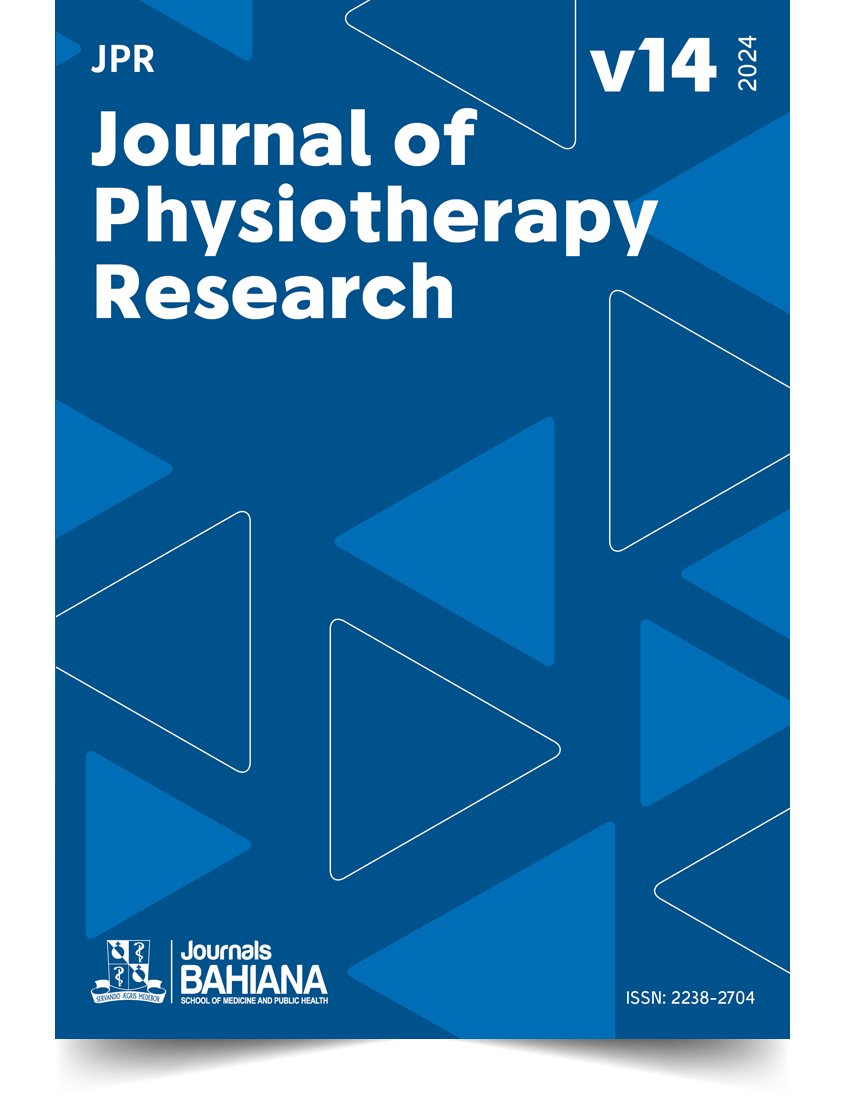Inspiratory pauses of 0.5 and 2.0 seconds during respiratory mechanics assessment do not produce hemodynamic changes in mechanically ventilated patients: cross-sectional study
DOI:
https://doi.org/10.17267/2238-2704rpf.2024.e5672Keywords:
Respiratory Mechanics, Physiotherapy, Hemodynamic MonitoringAbstract
INTRODUCTION: The heart-lung interaction is influenced by mechanical ventilation (MV), which directly impacts venous return and cardiac output through, but not limited to, adjustments in positive end-expiratory pressure (PEEP) and mean airway pressure (Pmean). Additionally, inspiratory pauses for the assessment of pulmonary mechanics interrupt thoracic movement, potentially further impacting this interaction. OBJECTIVE: To compare hemodynamic changes during 0.5 and 2.0-second inspiratory pauses during respiratory mechanics measurements. METHODS: This is a cross-sectional study conducted in the intensive care units of a hospital in Salvador/BA. Patients on MV and over 18 years old were included. Exclusions were made for those with hemodynamic instability and sustained hypoxemia during the evaluation. For sample characterization, patients were divided into groups with and without pulmonary conditions. The main data collected and analyzed were PEEP, Pmean, systolic blood pressure (SBP), diastolic blood pressure (DBP), mean arterial pressure (MAP), and heart rate (HR). For data comparison, Wilcoxon-Rank and Mann-Whitney tests were used for paired and unpaired data, respectively. RESULTS: Thirty-seven patients were included, with a median age of 63 years, 19 (51.4%) males, and 30 (81.1%) with an admission diagnosis of a clinical nature. No statistically significant hemodynamic changes were identified between the 0.5 and 2.0-second inspiratory pause times in the variables SBP (p=0.99), DBP (p=0.11), MAP (p=0.29), and HR (p=0.25). CONCLUSION: No hemodynamic variations were identified during respiratory mechanics measurements at 0.5 and 2.0-second inspiratory pauses.
Downloads
References
(1) Marini JJ, Rocco PRM, Gattinoni L. Static and dynamic contributors to ventilator-induced lung injury in clinical practice. Pressure, energy, and power. Am J Respir Crit Care Med. 2020;201(7):767-774. https://doi.org/10.1164/rccm.201908-1545CI DOI: https://doi.org/10.1164/rccm.201908-1545CI
(2) Gertler R. Respiratory Mechanics. Anesthesiol Clin. 2021;39(3):415-440. https://doi.org/10.1016/j.anclin.2021.04.003 DOI: https://doi.org/10.1016/j.anclin.2021.04.003
(3) Hickey SM, Sankari A, Giwa AO. Mechanical Ventilation. Florida: StatPearls; 2024.
(4) Menezes Júnior JN, Silva LM, Santos LJM, Correia HF, Lopes W, Silva VEP, et al. Reproducibility of respiratory mechanics measurements in patients on invasive mechanical ventilation. Rev Bras Ter Intensiva. 2020;32(3):398–404. Available from: https://www.scielo.br/j/rbti/a/cxtS76H9LgDxd3dR7hXhrDv/?lang=en&format=pdf DOI: https://doi.org/10.5935/0103-507X.20200068
(5) Henderson WR, Chen L, Amato MPB, Brochard LJ. FIFTY YEARS OF RESEARCH IN ARDS. Respiratory Mechanics in Acute Respiratory Distress Syndrome. Am J Respir Crit Care Med. 2017;196(7):822–33. https://doi.org/10.1164/rccm.201612-2495CI DOI: https://doi.org/10.1164/rccm.201612-2495CI
(6) West JB. Fisiologia Respiratória: Princípios Básicos. Porto Alegre: Artmed Panamericana; 2013.
(7) Su L, Pan P, Liu D, Long Y. Mean airway pressure has the potential to become the core pressure indicator of mechanical ventilation: Raising to the front from behind the clinical scenes. J Intensive Med. 2021;1(2):96–8. https://doi.org/10.1016%2Fj.jointm.2021.04.002 DOI: https://doi.org/10.1016/j.jointm.2021.04.002
(8) Salmorán HO, Martínez IM, Palos DC, Bautista KSL, Greene EJD. De la fisiología al ventilador, interacción corazón pulmón durante la ventilación mecánica. Med Crit. 2020;34(5):283–92. https://dx.doi.org/10.35366/96459 DOI: https://doi.org/10.35366/96459
(9) Long Y, Su L, Zhang Q, Zhou X, Wang H, Cui N, et al. Elevated mean airway pressure and central venous pressure in the first day of mechanical ventilation indicated poor outcome. Crit Care Med. 2017;45(5):e485–92. https://doi.org/10.1097/ccm.0000000000002290 DOI: https://doi.org/10.1097/CCM.0000000000002290
(10) Chicayban LM. Acute effects of ventilator hyperinflation with increased inspiratory time on respiratory mechanics: randomized crossover clinical trial. Rev Bras Ter Intensiva. 2019;31(3):289–95. Cited: PMID: 31618346 DOI: https://doi.org/10.5935/0103-507X.20190052
(11) Venezian IC. Efeito de duas modalidades ventilatórias para obtenção de flow bias expiratório na mecânica respiratória, oxigenação e hemodinâmica de pacientes submetidos à ventilação mecânica [dissertation] [Internet]. Rio Claro: Universidade Estadual Paulista; 2023. Available from: https://repositorio.unesp.br/items/c485ee0b-b2a6-4a17-93a0-c35689b7a61c
(12) Galhardo MM, Chermont SLSMC, Venancio ICDL, Lopes AJ, Guimaraes FS. Examining the haemodynamic repercussions of ventilator hyperinflation in elderly patients: An explanatory study. Respir Physiol Neurobiol. 2023;318(23). https://doi.org/10.1016/j.resp.2023.104165 DOI: https://doi.org/10.1016/j.resp.2023.104165
(13) Von Elm E, Altman DG, Egger M, Pocock SJ, Gøtzsche PC, Vandenbrouckef JP. Strengthening the reporting of observational studies in epidemiology (STROBE) statement: guidelines for reporting observational studies. BMJ. 2007;35(7624):806-8. https://doi.org/10.1136%2Fbmj.39335.541782.AD DOI: https://doi.org/10.1136/bmj.39335.541782.AD
(14) Brower RG, Matthay MA, Morris A, et al. Ventilation with lower tidal volumes as compared with traditional tidal volumes for acute lung injury and the acute respiratory distress syndrome. N Engl J Med. 2000;342(18):1301–8. https://doi.org/10.1056/NEJM200005043421801 DOI: https://doi.org/10.1056/NEJM200005043421801
(15) Sahetya SK, Wu TD, Morgan B, Herrera P, Roldan R, Paz E, et al. Mean Airway Pressure As a Predictor of 90-Day Mortality in Mechanically Ventilated Patients. Crit Care Med. 2020;48(5):688–95. https://doi.org/10.1097/ccm.0000000000004268 DOI: https://doi.org/10.1097/CCM.0000000000004268
(16) Demir S. Comparison of Normality Tests in Terms of Sample Sizes under Different Skewness and Kurtosis Coefficients. International Journal of Assessment Tools in Education. 2022;9(2):397–409. https://doi.org/10.21449/ijate.1101295 DOI: https://doi.org/10.21449/ijate.1101295
(17) Cavalcanti AB, Suzumura ÉA, Laranjeira LN, Paisani DM, Damiani LP, Guimarães HP, et al. Effect of lung recruitment and titrated Positive End-Expiratory Pressure (PEEP) vs low PEEP on mortality in patients with acute respiratory distress syndrome: A randomized clinical trial. JAMA. 2017;318(14):1335–45. https://doi.org/10.1001/jama.2017.14171 DOI: https://doi.org/10.1001/jama.2017.14171
Downloads
Published
Issue
Section
License
Copyright (c) 2024 Thainá Regina dos Santos, Tainã de Jesus Cerqueira Santos, Bruno Prata Martinez, Helder Brito Duarte

This work is licensed under a Creative Commons Attribution 4.0 International License.
This work is licensed under a Creative Commons Attribution 4.0 International License.



